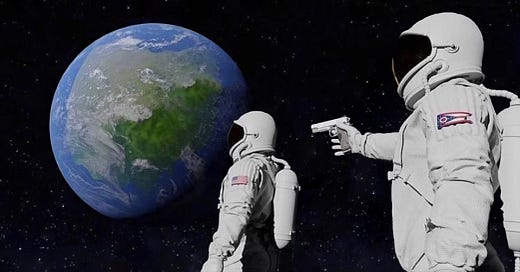A community of the bacteria Candidatus Desulforudis audaxviator has been discovered 2.8 kilometres beneath the surface of the Earth in fluid-filled cracks of the Mponeng goldmine in South Africa. Its 60C home is completely isolated from the rest of the world, and devoid of light and oxygen. …
99.9% of the DNA [there] belonged to one bacterium, a new species. The remaining DNA was contamination from the mine and the laboratory. … A community of a single species is almost unheard of in the microbial world. … Deep-sea vent communities, for instance … use oxygen … produced by photosynthesising plankton at the surface. ….
D. audaxviator gets its energy from the radioactive decay of uranium in the surrounding rocks. It has genes to extract carbon from dissolved carbon dioxide and other genes to fix nitrogen, which comes from the surrounding rocks. … D. audaxviator has genes to produce all the amino acids it needs. D. audaxviator can also protect itself from environmental hazards by forming endospores – tough shells that protect its DNA and RNA from drying out, toxic chemicals and from starvation. It has a flagellum to help it navigate.
That is New Scientist; here is Science. This news does it for me; much more likely likely than not, life on Earth came from life elsewhere.
Added: If life starts only on planets, the chance Earth life started on Earth is roughly the inverse of average number of planets seeded by each life origin. If not, the chance is lower. Here is more from Science:
[It] is prominent in small subunit rRNA gene clone libraries from almost all fracture fluids sampled to date from depths greater than 1.5 km across the Witwatersrand basin (covering 150 km by 300 km near Johannesburg, South Africa) … Severe nutrient limitation is believed to result in cell doubling times ranging from 100s to 1000s of years … Heterogeneity in the population … was quite low … suggesting a recent selective sweep or other population bottleneck. … We could not rule out the presence of organisms that might adhere to the surfaces of the fracture or that were smaller than the 0.2um filter pore … [It] appears capable of sensing nutrients in its environment.









Well, they don't "survive only on radioactive decay". The paper proposes that radiolysis acts on water and bicarbonate to provide some metabolic precursors that the bacteria need. But the precursors have to be there in abundance, and importantly, everything happens in an aqueous environment at 60°C. Their environment is wet and scalding hot - not what you find in a comet. Whether they could survive dormant in a deep-frozen piece of rock in interstellar space is an open question, of course -- but the data provided by the current study do not address that question. I don't think the odds on panspermia get an update with this discovery.
As an aside, the name Candidatus Desulforudis audaxviator is very interesting. The Candidatus is because it's never been seen - its existence is inferred from isolated DNA. Desulforudis refers to its metabolism. audaxviator, according to Wikipedia,
...comes of a quotation from Jules Verne's Journey to the Center of the Earth. The hero, Professor Lidenbrock, finds a secret inscription in Latin that reads: Descende, audax viator, et terrestre centrum attinges (Descend, bold traveller, and you will attain the center of the Earth).
"Stars pass close enough to each other often enough as to swap some of their comet clouds, and reproduction would be needed to counter natural decay I think."
In deep space, even if the organism's metabolism is powered entirely by radioactive decay, the loss of heat would prevent metabolic activity and reproduction. Even with modern engineering, there's no power source capable of sustaining the kinds of temperatures necessary for reproduction for millions of years, short of a full-scale nuclear reactor (see http://en.wikipedia.org/wik....